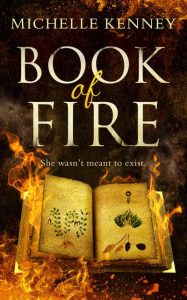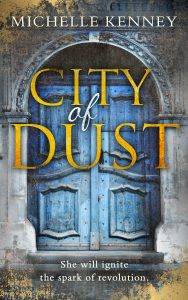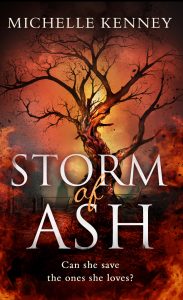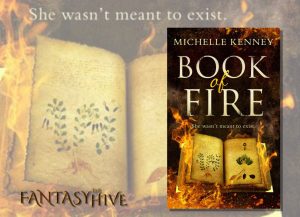THE BOOK OF FIRE TRILOGY by Michelle Kenney (BOOK REVIEW)
The Book of Fire Trilogy (Book of Fire, City of Dust, Storm of Ash) by Michelle Kenney
Content warnings: Violence, injury, and death, including major character death, death of children, and death of animals; attempted sexual assault; genetic and other medical experimentation; a lot of medical scenes.
Life outside the domes is not possible. At least that’s what Insiders are told. Twins Eli and Talia shouldn’t exist. They’re Outsiders.
Their home is a secret. Their lives are a secret. Arafel is a secret.
An unexpected forest raid forces Talia into a desperate mission to rescue her family while protecting the sacred book of Arafel from those who would use it as a weapon. As Talia and her life long friend Max enter the dome, she makes some unexpected discoveries, and allies, in the form of rugged Insider August, that will change the course of her life forever.
She’ll stop at nothing to save her family but will she sacrifice her heart in the process?
 First things first: I’m reviewing all three of these books together, because they feel to me like one complete story, and once you start, you’ll be desperate to read all the way through to the end for a seamless experience. This is a YA dystopian adventure in the classic style, full of non-stop adventure, revolutions against flawed social systems, and a smidgen of romance squeezed in amongst all the peril. I’m sure everyone’s completely fed up of YA dystopia being compared to The Hunger Games, but there are parts of this series that reminded me of the specific action-adventure vibe of The Hunger Games, not just the easy comparisons – the worldbuilding is completely different, but the heart-poundingness of the plot is a good match!
First things first: I’m reviewing all three of these books together, because they feel to me like one complete story, and once you start, you’ll be desperate to read all the way through to the end for a seamless experience. This is a YA dystopian adventure in the classic style, full of non-stop adventure, revolutions against flawed social systems, and a smidgen of romance squeezed in amongst all the peril. I’m sure everyone’s completely fed up of YA dystopia being compared to The Hunger Games, but there are parts of this series that reminded me of the specific action-adventure vibe of The Hunger Games, not just the easy comparisons – the worldbuilding is completely different, but the heart-poundingness of the plot is a good match!
There is a lot going on in the world-building here, and it’s amazing that such intricacy is packed into relatively short books without becoming confusing. Talia’s home, Arafel, is a secret community in the forests of a post-apocalyptic Britain that’s now rewilded; their society is very equal, with everyone pulling their weight and living in harmony with the land around them, farming and hunting. Oh, and all kinds of wild animals abound, because in the fall of civilisation the zoos were breached, and the climate changed, and now everything from monkeys to snow leopards make their home in Britain – there’s a domesticated snow leopard who’s wonderful! They’re threatened, however, by the advanced technological society that’s grown up inside the domes, known as the Pantheon – the dome-dwellers’ society is simultaneously futuristic and Ancient Roman, and is packed with genetically modified people, animals and mythical beasts, all tailor-made in a very Brave New World kind of way to maintain a heavily stratified society, from the powerful Equites (knights) down to the indentured and neglected Prolets (workers). Throw in a lot of genetics discussion, mythological references, and a key plotline involving the Voynich manuscript, and there’s even more going on! It’s a mix of so many elements, and I’m astonished it all fit in.
 What I really found refreshing was that in many YA dystopias, our feisty heroine would be a member of the ground-down Prolet underclass, working from within the system to dismantle it, whereas here, Talia is totally outside the faux-Roman system, and so her perspective on it is very different. At times I thought Arafel was perhaps a little too idealised (I’m still not sure if education would hold up so well through the fall of civilisation, for example, but Talia seems to have as much, if not more, knowledge about science as a modern teenager!) but it makes a great “normal” contrast that heightens how shocking dome life is, in a way that a Prolet viewpoint wouldn’t have been able to offer. The existing Prolet resistance is integral to the plot throughout, but it’s also not Talia’s focus; though she is horrified by what the Pantheon has become, her goals are much more simple to begin with. She wants to rescue her family members (who keep getting kidnapped), protect her secret, and go safely home to Arafel – she’s not here with a grand plan, and I really enjoyed that. I’m trying not to reveal too much about the plots of the second and third books, but the way Talia’s journey moves from the small scale to the huge will be very satisfying for fans of the genre.
What I really found refreshing was that in many YA dystopias, our feisty heroine would be a member of the ground-down Prolet underclass, working from within the system to dismantle it, whereas here, Talia is totally outside the faux-Roman system, and so her perspective on it is very different. At times I thought Arafel was perhaps a little too idealised (I’m still not sure if education would hold up so well through the fall of civilisation, for example, but Talia seems to have as much, if not more, knowledge about science as a modern teenager!) but it makes a great “normal” contrast that heightens how shocking dome life is, in a way that a Prolet viewpoint wouldn’t have been able to offer. The existing Prolet resistance is integral to the plot throughout, but it’s also not Talia’s focus; though she is horrified by what the Pantheon has become, her goals are much more simple to begin with. She wants to rescue her family members (who keep getting kidnapped), protect her secret, and go safely home to Arafel – she’s not here with a grand plan, and I really enjoyed that. I’m trying not to reveal too much about the plots of the second and third books, but the way Talia’s journey moves from the small scale to the huge will be very satisfying for fans of the genre.
 There is a small amount of romance here, along with the dreaded dystopian love triangle, but it’s actually not as prominent as I was expecting; I actually felt that the emphasis was more on the friendships Talia makes, and the group she gathers around her. The contrast between the kind, equal Arafel and the cold, regimented Pantheon makes it clear there’s a theme of whether humans can be ‘improved’ so far that they lose their humanity, and there are parallels to be drawn to animal and human exploitation throughout history, from arena battles to medical experimentation. The various mythological beasts that have been recreated are so interesting to read about – griffins! a cyclops! a minotaur! – but they do throw up a number of ethical concerns, which is a subject that’s leaned into heavily in the final book. That book in particular has a nice balance of exciting action and more thought-provoking moments.
There is a small amount of romance here, along with the dreaded dystopian love triangle, but it’s actually not as prominent as I was expecting; I actually felt that the emphasis was more on the friendships Talia makes, and the group she gathers around her. The contrast between the kind, equal Arafel and the cold, regimented Pantheon makes it clear there’s a theme of whether humans can be ‘improved’ so far that they lose their humanity, and there are parallels to be drawn to animal and human exploitation throughout history, from arena battles to medical experimentation. The various mythological beasts that have been recreated are so interesting to read about – griffins! a cyclops! a minotaur! – but they do throw up a number of ethical concerns, which is a subject that’s leaned into heavily in the final book. That book in particular has a nice balance of exciting action and more thought-provoking moments.
I actually think the second book was my favourite of the three, because the story is in full swing and it’s packed with page-turning action, and I think that’s because of the overall shape of the trilogy. I highly recommend treating this as a single story split into three parts, rather than three individual linked stories; you’ll find the pacing much more rewarding if you view it as a whole. Even together the whole thing is a really quick read, so if you’re feeling nostalgic for the hey-day of YA dystopian fiction, this is definitely a series to track down.
The Book of Fire Trilogy is available from:
Amazon.co.uk | Amazon.com

